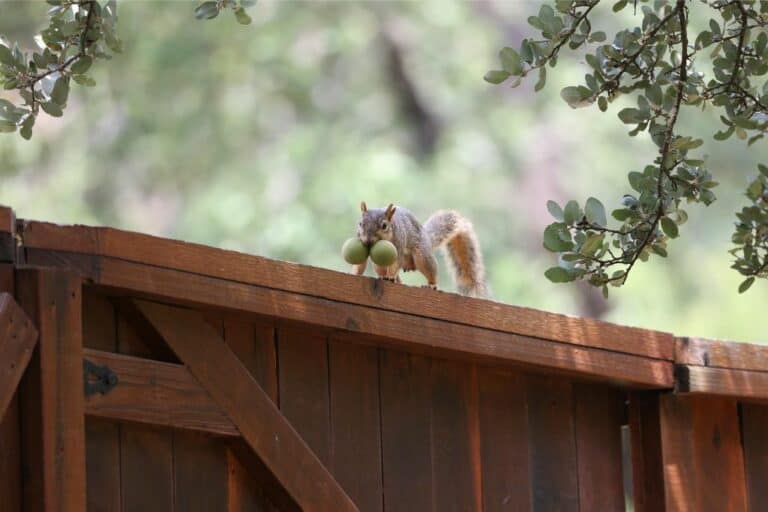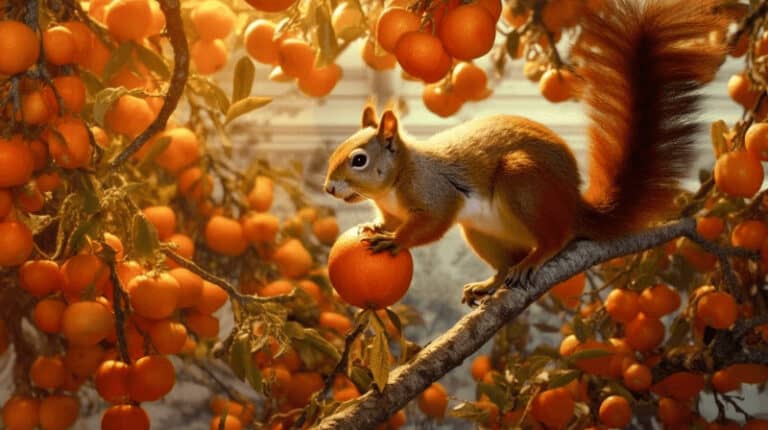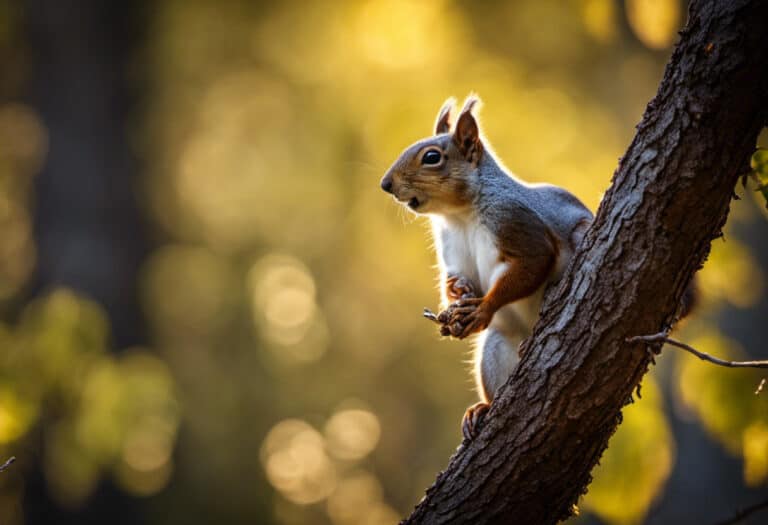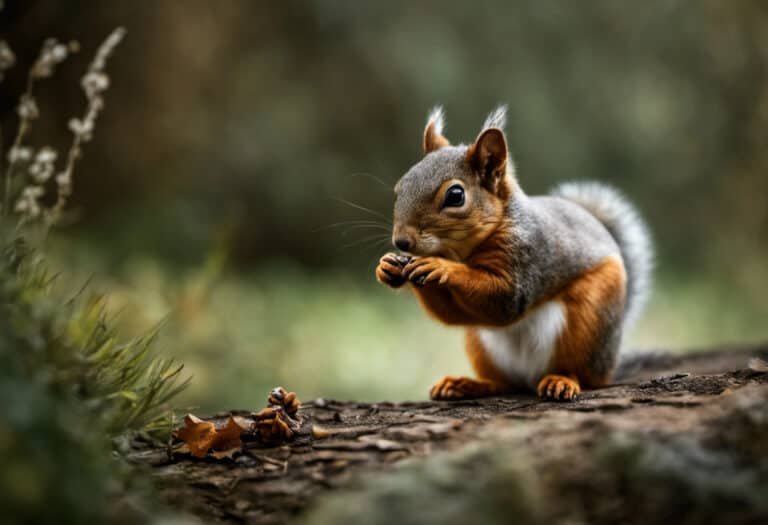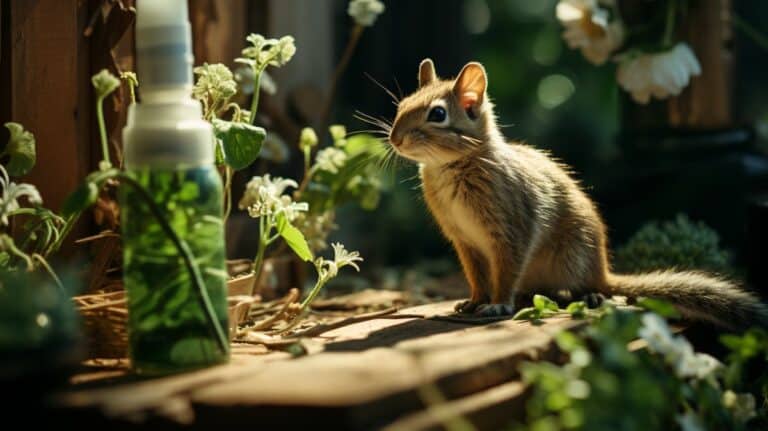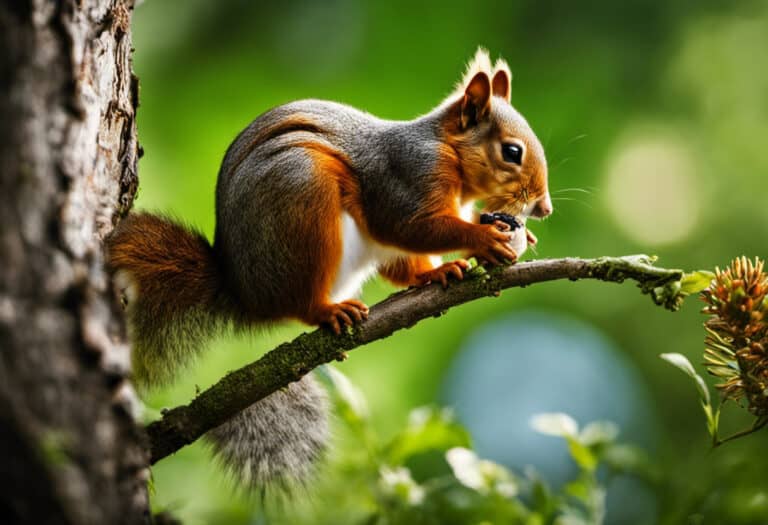What Squirrels Are in California?
Are you curious about the diverse squirrel species that call California home? Look no further! In this article, we’ll delve into the fascinating world of California squirrels, including the native Western Gray Squirrel and the introduced Eastern Gray Squirrel and Eastern Fox Squirrel.
Get ready to learn about the hoarding habits of the native Douglas Squirrel and the plant-threatening California Ground Squirrel. We’ll also explore the cryptic Flying Squirrels, including the recently classified Humboldts Flying Squirrel.
Join us as we uncover the various threats these squirrels face in California’s changing landscape.
Key Takeaways
- There are several species of squirrels found in California, including the native Western Gray Squirrels, Douglas Squirrels, and California Ground Squirrels, as well as the introduced Eastern Gray Squirrels and Eastern Fox Squirrels.
- The Western Gray Squirrels are predominant in oak woodlands and pine and oak forests, while the Douglas Squirrels are found in conifer-forested regions of the north coastal area and Sierra Nevada Mountains.
- The Eastern Gray Squirrels and Eastern Fox Squirrels, both introduced from the eastern part of the United States, have become common in California and can be found in urbanized areas.
- The different squirrel species in California face various threats, including habitat loss, competition with other squirrel species, and diseases like Notoedric Mange. Douglas Squirrels also face predation from feral cats.
Native Western Gray Squirrels
Native Western Gray Squirrels are common in oak woodlands and forests in California. They can also be found in built-up areas due to the loss of natural habitat.
These squirrels have specific habitat preferences. They often choose areas with mature oak trees and dense vegetation. They are known for their population dynamics, which are influenced by factors such as food availability and predation.
Behavioral adaptations of Western Gray Squirrels include their ability to cache food in various locations. This allows them to store and retrieve food when resources are scarce.
Reproduction patterns involve a single annual breeding season. This typically occurs in late winter or early spring.
Conservation efforts for Western Gray Squirrels include preserving and restoring their natural habitats. Measures to reduce habitat fragmentation are also implemented. Additionally, managing populations is important to prevent further decline.
Eastern Gray Squirrels
Introduced from the eastern part of the United States, Eastern Gray Squirrels vary in color, with some having a reddish tint. These medium-sized squirrels have relatively narrow tails and shorter ears.
Bold and aggressive, they often take over backyards and bird feeders, making them one of the most destructive squirrel types. Eastern Gray Squirrels have had a significant impact on native squirrel species in California, particularly the native Western Gray Squirrels.
Their habitat preferences include urbanized areas, where they thrive around people. Conservation efforts have focused on managing their population and reducing their negative effects on native species.
Management strategies such as trapping and relocation have been implemented to control their spread. Understanding their behavioral adaptations and habitat preferences is crucial for effective management and conservation efforts.
| Eastern Gray Squirrels | Conservation efforts | Impact on native species | Habitat preferences | Behavioral adaptations |
|---|---|---|---|---|
| Introduced species | Trapping and relocation | Competition with native species | Urbanized areas | Bold and aggressive behavior |
Eastern Fox Squirrels
You’ll find that the Eastern Fox Squirrels, the largest tree squirrels in the state, have varying coat colors, but their grizzled yellow-brown or tan underside can identify them.
These squirrels inhabit various habitats, including urbanized areas where they thrive around people.
They are very athletic and excellent climbers. Regarding behavior, Eastern Fox Squirrels are known to be active during the day, foraging for food and engaging in social interactions. Their diet consists of various food items, including nuts, fruits, seeds, and even bird eggs.
The population of Eastern Fox Squirrels in California is relatively stable, and there have been conservation efforts to protect their natural habitats and promote their coexistence with humans. These efforts include preserving urban green spaces and implementing programs to reduce conflicts between squirrels and humans.
Native Douglas Squirrels
Found in conifer-forested regions, Douglas Squirrels are known for their color-changing coats and hoarding behavior. Here are four key aspects of their biology and ecology:
- Habitat preferences of native Douglas squirrels: These squirrels thrive in coniferous forests, particularly in the north coastal areas and Sierra Nevada Mountains of California. They are well-adapted to this habitat, utilizing the trees for shelter and food.
- Diet and foraging behavior of Douglas squirrels: Their preferred diet includes seeds from Douglas Firs, Sitka Spruces, and Shore Pine trees. They have specialized cheek pouches that allow them to carry food to their caches, which they often store in the same place for generations.
- Reproduction and breeding patterns of Douglas squirrels: They typically breed from late winter to early spring, and females give birth to a litter of 2-4 young. The young are weaned at around 8 weeks old and become sexually mature at one year of age.
- Interactions and competition with other squirrel species in the Pacific Northwest: Douglas squirrels face competition from other squirrel species, such as Western Gray Squirrels and Eastern Gray Squirrels, for food and habitat resources. They may also experience predation from feral cats, American Martens, bobcats, hawks, and owls.
Additionally, competition with introduced squirrel species and predation by various predators further challenges their survival. Conservation efforts focus on protecting their habitat, managing invasive species, and raising awareness about their ecological importance.
California Ground Squirrels
The California Ground Squirrel, a common species in the state, stores food in its cheeks to eat later.
These squirrels have a varied diet consisting of seeds, fruit, and roots, which poses a potential danger to plants. They are primarily found in open habitats such as grasslands, meadows, and agricultural fields.
California Ground Squirrels are widely distributed throughout California, ranging from the coastal areas to the foothills of the Sierra Nevada Mountains. They have a complex reproductive and life cycle, with females giving birth to litters of 5-15 young.
Interactions with humans can be both positive and negative. While these squirrels can be considered a nuisance due to their burrowing habits and potential damage to crops, they also play a role in seed dispersal and provide food for predators.
Currently, the California Ground Squirrel is classified as a species of least concern in terms of conservation status.
Humboldts Flying Squirrel
When observing Humboldt’s Flying Squirrels, it’s fascinating to see how their gliding ability gives the impression of flight. Here are four interesting facts about these unique squirrels:
- Conservation efforts: Humboldt’s Flying Squirrels are a species of concern due to habitat loss and fragmentation caused by logging and wildfires. Conservation organizations are working to protect their forested habitats and promote sustainable logging practices.
- Habitat preferences: These squirrels inhabit coniferous forests in southern British Columbia, Washington, Oregon, and northern California. They rely on large, mature trees for nesting and gliding between trees.
- Behavior patterns: Humboldt’s Flying Squirrels are nocturnal and spend most of their time in trees. They are agile climbers and use their gliding ability to move swiftly through the forest canopy.
- Diet and feeding habits: Their diet consists mostly of nuts, seeds, berries, and fungi. They are known to store food in tree cavities or underground caches for winter months when food is scarce.
Understanding the conservation efforts, habitat preferences, behavior patterns, and diet of Humboldt’s Flying Squirrels is crucial for their protection and long-term survival.
Douglas Squirrels
Moving on from the Humboldts Flying Squirrel, let’s delve into the world of Douglas Squirrels. These small, native squirrels, scientifically known as Tamiasciurus douglasii, are found exclusively in the Pacific Northwest, ranging from the Sierra Mountains in California to southern British Columbia.
Douglas Squirrels have distinctive behavior patterns and habitat preferences. They primarily reside in coniferous forests, utilizing various calls to warn of predators or threats. When it comes to reproduction, not much is known about their lifespan.
However, they are known to hoard food in one location, resulting in piles of discarded pine scales. In terms of diet, these squirrels have a preferred taste for seeds from Douglas Firs, Sitka Spruces, and Shore Pine trees.
When it comes to interaction with other squirrel species, Douglas Squirrels have their own territory and may compete for resources, but they generally coexist peacefully.
| Behavior Patterns | Habitat Preferences | Reproduction Habits |
|---|---|---|
| Use various calls to warn of predators or threats | Primarily live in coniferous forests | Not much is known about their lifespan |
| Diet and Feeding Habits | Interaction with other squirrel species | |
| Preferred diet includes seeds from Douglas Firs, Sitka Spruces, and Shore Pine trees | Coexist peacefully with other squirrel species, but may compete for resources |
Humboldts and Northern Flying Squirrels
To differentiate between Humboldts and Northern Flying Squirrels, you can rely on DNA tests as their appearance is almost identical.
However, there are some slight differences in size and fur color. Humboldts Flying Squirrels are slightly smaller and have darker fur than Northern Flying Squirrels.
Regarding habitat preferences, Humboldts Flying Squirrels are found in coniferous forests in southern British Columbia, Washington, Oregon, and northern California. Northern Flying Squirrels have a wider range, including coniferous and deciduous forests across North America.
Regarding behavioral traits, both species are small, nocturnal, and capable of gliding from tree to tree using a patagium. Conservation efforts for both species include preserving their forest habitats and conducting genetic studies to understand their populations and genetic diversity better.
Threats to Squirrel Species in California
If you’re living in California, you should be aware of the threats that squirrel species face in the state. Here are four important factors that impact the survival of squirrels:
- Effects of urbanization on squirrel populations: As cities expand, natural habitats are being replaced by buildings and roads, leading to a loss of suitable environments for squirrels.
- Impact of wildfires on western gray squirrels: Wildfires are a significant threat to the survival of western gray squirrels. These fires destroy their habitats and disrupt their food sources.
- Competition between native and invasive squirrel species: Introducing invasive species, such as the eastern gray squirrels and fox squirrels, threatens native squirrel populations. These invasive species compete for resources and can outcompete the natives.
- Disease threats to squirrel populations in California: Squirrels in California face the risk of diseases, including notoedric mange caused by mites. This disease can lead to severe skin lesions and even death in affected individuals.
In addition to these threats, Douglas squirrels face predation risks from feral cats, American martens, bobcats, hawks, and owls. Understanding and addressing these threats is crucial to ensure the long-term survival of squirrel populations in California.
Conclusion
In conclusion, California is home to a diverse range of squirrel species. The native Western Gray Squirrel faces challenges due to habitat loss caused by wildfires and urbanization.
The invasive Eastern Gray Squirrel and Eastern Fox Squirrel, both introduced from the eastern United States, are considered invasive species.
The Douglas Squirrel, native to the Pacific Northwest, is known for its hoarding behavior and vocalizations.
The California Ground Squirrel threatens plants due to its dietary preferences.
Finally, the Humboldts Flying Squirrel, previously classified as Northern Flying Squirrels, is a cryptic species found in coniferous forests.
These squirrel species face various threats, including competition, habitat loss, and predation.
